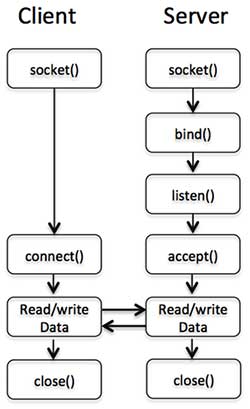How To: Perl TCP / UDP Socket Programming using IO::Socket::INET
2020-11-15 00:23
标签:des com class blog http code div img java style javascript http://www.thegeekstuff.com/2010/07/perl-tcp-udp-socket-programming/ In this article, let us discuss how to write Perl socket programming using
the inbuilt socket modules in Perl. Perl socket modules provides an object interface that makes it easier to
create and use TCP / UPD sockets. This article covers the following topics: CPAN module IO::Socket::INET is used to perform socket operations such as —
creating, binding, connecting, listening and closing the socket. IO::Select module is used for obtaining the descriptors that are ready for
read/write operations. TCP is a connection oriented networking protocol. In this example, let us
review the Perl code-snippet that will explaining us the simple client and
server communication. The socket operation such as socket creation, binding and listening to the
socket is performed by the IO::Socket::INET module. The Perl code given below does the following: The Perl code given below does the following: The Perl code given below does the following: The Perl code given below does the following: http://www.tutorialspoint.com/perl/perl_socket_programming.htm To explain above mentioned socket concept we will take an example of Client -
Server Programming using Perl. To complete a client server architecture we would have to go through the
following steps: Create a socket using socket call. Bind the socket to a port address
using bind call. Listen to the socket at the port address
using listen call. Accept client connections using accept call. Create a socket with socket call. Connect (the socket) to the server
using connect call. Following diagram shows complete sequence of the calls used by Client and
Server to communicate with each other: How To: Perl TCP / UDP Socket Programming using
IO::Socket::INET,搜素材,soscw.com How To: Perl TCP / UDP Socket Programming using
IO::Socket::INET 标签:des com class blog http code div img java style javascript 原文地址:http://www.cnblogs.com/shangdawei/p/3695194.html
Perl TCP Client and Server
Perl TCP Server Operation

#!c:\perl\bin\perl.exe
#tcpserver.pl
use IO::Socket::INET;
# flush after every write
$| = 1;
my ($socket,$client_socket);
my ($peeraddress,$peerport);
# creating object interface of IO::Socket::INET modules which internally does
# socket creation, binding and listening at the specified port address.
$socket = new IO::Socket::INET (
LocalHost => ‘61.52.222.111‘,
LocalPort => ‘8888‘,
Proto => ‘tcp‘,
Listen => 5,
Reuse => 1
) or die"ERROR in Socket Creation : $!\n";
print "SERVER Waiting for client connection on port 8888";
while(1)
{
# waiting for new client connection.
$client_socket = $socket->accept();
# get the host and port number of newly connected client.
$peer_address = $client_socket->peerhost();
$peer_port = $client_socket->peerport();
print "Accepted New Client Connection From : $peeraddress:$peerport\n";
# write operation on the newly accepted client.
$data = "DATA from Server";
print $client_socket "$data\n";
# we can also send the data through IO::Socket::INET module,
# $client_socket->send($data);
# read operation on the newly accepted client
$data = $client_socket>;
# we can also read from socket through recv() in IO::Socket::INET
# $client_socket->recv($data,1024);
print "Received from Client : $data\n";
}
$socket->close();

Perl TCP Client Operation

#!c:\perl\bin\perl.exe
#tcpclient.pl
use IO::Socket::INET;
# flush after every write
$| = 1;
my ($socket,$client_socket);
# creating object interface of IO::Socket::INET modules which internally creates
# socket, binds and connects to the TCP server running on the specific port.
$socket = new IO::Socket::INET (
PeerHost => ‘61.52.222.111‘,
PeerPort => ‘8888‘,
Proto => ‘tcp‘,
) or die "ERROR in Socket Creation : $!\n”;
print "TCP Connection Success.\n”;
# read the socket data sent by server.
$data = $socket>;
# we can also read from socket through recv() in IO::Socket::INET
# $socket->recv($data,1024);
print "Received from Server : $data\n”;
# write on the socket to server.
$data = "DATA from Client”;
print $socket "$data\n”;
# we can also send the data through IO::Socket::INET module,
# $socket->send($data);
sleep (10);
$socket->close();

Perl UDP Server

#!c:\perl\bin\perl.exe
#udpserver.pl
use IO::Socket::INET;
# flush after every write
$| = 1;
my ($socket,$received_data);
my ($peeraddress,$peerport);
# we call IO::Socket::INET->new() to create the UDP Socket and bound
# to specific port number mentioned in LocalPort and there is no need to provide
# LocalAddr explicitly as in TCPServer.
$socket = new IO::Socket::INET (
LocalPort => ‘8888‘,
Proto => ‘udp‘,
) or die "ERROR in Socket Creation : $!\n";
while(1)
{
# read operation on the socket
$socket->recv($recieved_data,1024);
#get the peerhost and peerport at which the recent data received.
$peer_address = $socket->peerhost();
$peer_port = $socket->peerport();
print "\n($peer_address , $peer_port) said : $recieved_data";
#send the data to the client at which the read/write operations done recently.
$data = "data from server\n";
print $socket "$data";
}
$socket->close();

Perl UDP Client

#!c:\perl\bin\perl.exe
#udpclient.pl
use IO::Socket::INET;
# flush after every write
$| = 1;
my ($socket,$data);
# We call IO::Socket::INET->new() to create the UDP Socket
# and bind with the PeerAddr.
$socket = new IO::Socket::INET (
PeerAddr => ‘61.52.222.111:8888‘,
Proto => ‘udp‘
) or die "ERROR in Socket Creation : $!\n";
#send operation
$data = "data from client";
$socket->send($data);
#read operation
$data = $socket>;
print "Data received from socket : $data\n ";
sleep(10);
$socket->close();

To create a server
To create a client

下一篇:收藏php
文章标题:How To: Perl TCP / UDP Socket Programming using IO::Socket::INET
文章链接:http://soscw.com/index.php/essay/21335.html